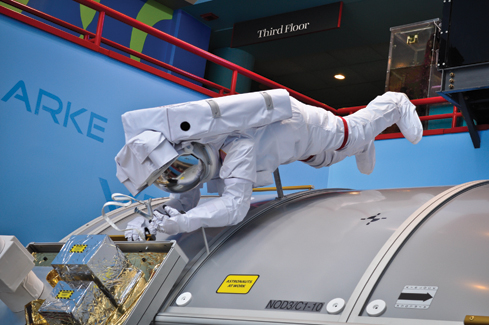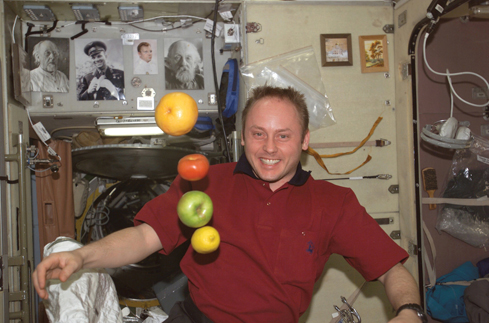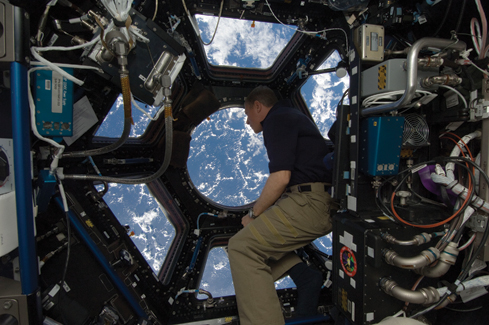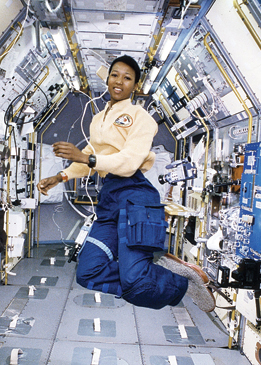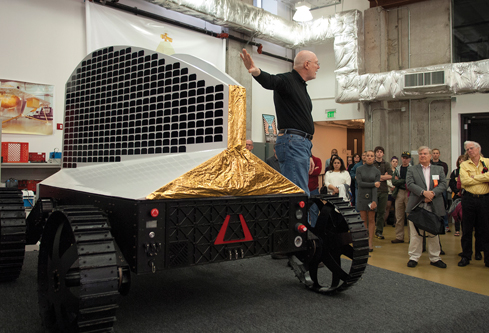 |
||||||||||||||||
|
Our Place in Space
No longer rocketing to the moon and back, we still have a place in space, say NASA scientists and astronauts. A new Science Center exhibition, SpacePlace, takes us there. In the summer of 1969 a boy of 8 stood in his backyard in Sharon, Pa., one of many young faces speckling lawns and parking lots and rooftops across the United States, looking up and reflecting the light of the moon.
“When Neil Armstrong landed on the moon it was late at night,” says Dennis Bateman, now director of exhibit experience at Carnegie Science Center. “I remember looking at the television, looking up at the moon outside, and having that sense of immediacy.” It was this precise moment that birthed the sense in so many young minds that space—this unquantifiable and inherently unknowable expanse—felt somehow a little more like something you could touch. The temptation to explore was unimaginable, and it was exciting. Fast forward four decades, and the relationship between the public and space is a far different one. We may know exploration is happening, somewhere, but do we really know what it’s all about? And are we still awed by its potential? “Before, we were building the space station. Now, we’re focusing on research. And some of the things that are going to come out are going to truly be blowing our minds.”
– NASA Astronaut Mike FinckeThe initial thrill of space travel extended into 1981, when the Space Shuttle launched and became, for the next 30 years, the sole focus and identity of NASA. “But sometime during the following decades, there started to be so many of them that it seemed kind of like second nature,” says Ron Baillie, co-director of Carnegie Science Center. Now the shuttle program is over—the last journey completed in 2011—and people are left wondering about the American role in space. Or worse, Baillie says, they’re not thinking about it at all. “Just because the shuttle program ended, our role in space hasn’t.” A fitting time, he adds, for Carnegie Science Center to launch SpacePlace, a new permanent exhibition that engages the public—in accessible, hands-on ways—with what’s happening in space, right now. Life in spaceBateman first mapped the exhibition years ago on a napkin sketch that featured this centerpiece: a full-scale replica of two modules of the International Space Station (ISS). The ISS continuously houses a crew of six, currently including two Americans.
“When you step over that threshold, for a few minutes, everything you see looks like you’re on the space station,” says Bateman. There’s a bed on the wall, an astronaut floating above you, and everything is tilted. “Immediately you’re immersed in this disorienting space.” SpacePlace instantly establishes the connection: There are people in space right now, and this is what they see. And by helping people—especially children—envision the life of an astronaut, they might be better able to visualize their own role in space or other scientific endeavors. Perhaps the best local example of this success is astronaut and Emsworth native Mike Fincke, who as a boy visited the old Buhl Planetarium and Institute of Popular Science on the North Side and became entranced by the mysteries beyond Earth’s atmosphere. Fincke has spent more time in space than any American in history, including more than a year on the International Space Station. “I’m sticking with NASA until they kick me out,” Fincke says from the Lyndon B. Johnson Space Center in Houston, where he’s based today. Of his time aboard the ISS, he says, “I think people would be most surprised by normal, day-to-day things, like: We don’t have a shower. Or, we have to use a certain kind of funny-looking toilet. It’s this day-to-day life—how different it is, and how similar.” Bateman jokes about one of his favorite parts of the exhibition: “You’ll be able to take your picture sitting on a space toilet!” But SpacePlace gets at a much bigger point, he notes. It’s this idea that humans have an amazing capacity to adapt to new environments. “People live in the Amazon; they live in the Arctic. Being able to live in space? Until they went up there, nobody really knew what was going to happen.” Today, we watch astronauts floating down the hall of the space station in t-shirts and shorts. It all seems so bizarrely normal. But at first, there were questions like: Will astronauts be able to see? Ongoing research on the space station looks at, among other things, the effects of longer-term weightlessness on the human body. The human eye, for example, is shaped by gravity on Earth, and a weightless environment can cause a subtle shift just strong enough to throw off vision. Some astronauts, in fact, have experienced weakened eyesight upon returning to Earth, though the cause is unknown and still being explored. Similarly, studies are ongoing about how spaceflight affects bone density and muscle strength. In a strange way, humans end up going to outer space and learning a lot more about themselves. Interstellar researchThe zero-gravity environment is surely one of the most sought-after sensations of spaceflight. And at SpacePlace, it’s not just left to the imagination. After passing through the ISS module, a visitor emerges to the other side to see people bobbing up and down through the air. “You’re on a harness that balances off your weight, so when you jump you keep floating up. Or if you push yourself down you keep going down,” says Baillie, who’s personally excited about this part of the exhibition. It’s something he says Science Center-goers have been requesting for years.
The two-story simulator replicates what it’s like to do repairs and construction on the ISS, which was a huge part of early missions there. Throughout his time in orbit, astronaut Fincke logged 48 hours and 37 minutes of “extra-vehicular time” on nine spacewalks. “Before, we were building the space station. Now, we’re focusing on research,” he says. “And some of the things that are going to come out are going to truly be blowing our minds.”
Fincke’s last mission to space, which was also the penultimate flight of the NASA Shuttle program, successfully delivered and docked a very important piece of equipment called the Alpha Magnetic Spectrometer (AMS) to the outside of the ISS. It’s a state-of-the-art particle physics detector that’s helping scientists around the world better investigate what the universe is made of and how it formed. In its first 18 months, the AMS has come into contact with about 24 billion cosmic rays— these are high-energy particles from exploded stars, black holes, and who knows what else hurling through space at immense speeds. When they smash into the spectrometer, the instrument catalogs and beams data back to more than 600 physicists around the globe. “It is I think by far the biggest collaboration of its kind for a space-based experiment,” says Trent Martin, AMS project manager at NASA, who notes large-scale collaboration is common in other scientific fields but relatively new in space. More than 60 institutions contributed funding to the AMS, and this diversification enables costly research to run continuously. “When one group is having trouble with resources, another may not be, and they can pick up where one group has left off,” says Martin. Currently, the space station is the host of 114 experiments running between now and March 2013 that span the fields of science, including chemistry, biology, earth sciences, astronomy, and even botany. In October, astronauts began two new experiments measuring how well Arabidopsis, a small flowering plant, can grow in space. Using plants to provide stable sources of oxygen, food, and water could save the time and money it takes to resupply the ISS, as well as equip NASA to better plan for long-range space travel. Throughout SpacePlace, visitors can explore hands-on stations replicating the diversity of those experiments. And for young people, the exhibition has an interactive career guide touting the many more jobs in the space industry other than being an astronaut—like the scuba divers who help train astronauts underwater in preparation for weightlessness, or the artists who create new renderings of discovered plants. The discussion that needs to happen isn’t necessarily one for engineering students already interested in space, Bateman says. “It’s about getting new faces to understand there are points of access for everyone.” The here and nowPerhaps the greatest challenge to engaging young students in science is adults, says Mae Jemison, M.D., a former NASA astronaut and the first African American woman in space. “All children are born interested in science. It’s up to us—the adults—to engage their innate curiosity, creativity, and motivation.” Jemison now travels widely as national spokesperson for Pittsburgh-based healthcare and medical product company Bayer and is a strong advocate for increasing science literacy among youth. She says surveys commissioned by Bayer found that more than half of professional scientists and engineers became interested in science before the age of 11, and she underscores the importance of the out-of-classrooms experiences.
“When students participate in these types of handson, hearts-on, minds-on activities, they are developing important science literacy skills—things like working in teams, thinking critically, and being able to solve problems,” Jemison says, noting these are skills that serve students well no matter what field they go into. “It’s all about giving students the ability to think their way through the day.”
Fincke adds that in addition to inspiring the next generation of discovery, public engagement in science has real ramifications for what we’re able to accomplish today. He dreams of a day when NASA will travel beyond low Earth orbit to places like asteroids and Mars. “The way our country works is if people want to do it, it gets in the budget,” he says. “If it gets in the budget, then we can go fly in space. It’s great to be part of a democracy. Our space program is the people’s space program. It’s the public’s space program, so we answer to them.” While historically much of space exploration was federally funded, privately owned companies—including one in Pittsburgh (see sidebar)—are increasingly leading the way. Privatization might lead to a newly efficient industry with more frequent missions and faster discovery —which will all require more trained scientists. “When students participate in these types of hands-on, hearts-on, minds-on activities, they are developing important science literacy skills—things like working in teams, thinking critically, and being able to solve problems.”
– Mae Jemison, Former NASA AstronautIt’s the hope at the Science Center that a few of those newcomers will be inspired by experiences like SpacePlace, where they might find that sort of immediacy Bateman found as a child, looking up at the moon. Bateman is already anticipating the moment when a visitor to SpacePlace, while watching a featured broadcast of a live feed from inside the ISS, will make that kind of special connection. “At some point during the day,” he says, “a visitor’s going to be doing some experiment and look over at the monitor and there’s an astronaut doing the same thing in space.”
Touching the Prize
Sixteen years ago, roboticist and Carnegie Mellon University professor Red Whittaker sent a proposal to NASA. It went something like this, according to Whittaker: “Dear NASA, let’s go on a mission. Let’s go drill and discover the moon ice.” This was before lunar ice was proven to exist, he adds. NASA, citing lack of evidence, turned him down. But Whittaker understood the rolling momentum of discovery. “Anytime you’re in enterprise—and that is scientific, engineering, or business—‘no’ is really ‘no for now,’” he says. Today, we know there’s ice on the moon (a 2009 NASA probe collided with the moon’s south pole and created a cloud containing water). We also have high-definition imagery of the lunar surface, a tremendous tool for building the software needed to help a rover land autonomously. “Something that was profoundly difficult becomes pragmatic,” says Whittaker. It’s a rainy Monday in October, and as Whittaker sits in his high-ceilinged CMU Planetary Robotics Lab, he has exactly 1,100 days before his lunar rover, Polaris, launches from Cape Canaveral. The mission is one of 25 such projects worldwide jumpstarted by the Google Lunar X PRIZE, which awards $20 million to the first privately-funded team to land a rover on the moon that travels 500 meters and returns video imagery of the surface. The prize has the effect of “raising all ships” and generating new momentum for private-industry space exploration, says Whittaker, who is CEO of Astrobotic, the CMU spinoff responsible for Polaris. In October 2015, the fin-shaped robot standing 5.5 feet tall will hurtle into space, land near the moon’s north pole, and mine for ice using power generated by solar panels encasing its exterior. Finding resources like water, ammonia, and methane, says Whittaker, could support a refueling station and deeper space flight, as well as future settlements on the moon. One of the biggest challenges left before launch day is refining the computer vision that helps the rover land, he says: “It’s a binary outcome. Once you engage with gravity you’re going to either land or crash.” Once on the surface, the trick will be staying out of battery-killing permanent shadows produced by the sun’s low position in the sky. In the meantime, Whittaker keeps careful watch on his competition (he calls Astrobotic, Barcelona Moon Team, and Silicon Valley’s Moon Express “the big three”). But he insists it’s not really about winning the prize. “If I had the choice between touching the water or nailing the prize, I’d go for the water,” he says. “For me, it’s not over until you touch it.”
|
||||||||||||||||
Breaking Out of the Cube · Reimagining Home · Southern Exposure · Directors' Note · NewsWorthy · Face Time: Tina Kukielski · Artistic License: Hacking Reality · Science & Nature: Going Buggy · Field Trip: Where in the World is Carnegie Museums? · The Big Picture
 |
Copyright © 2017 CARNEGIE Magazine. All rights reserved. |

